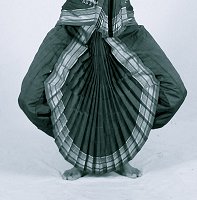
|  |

|  |
 Application of ballet technique for Bharatanatyam dancers - Veena Basavarajaiah, Bangalore e-mail: veenabasavarajaiah@gmail.com May 22, 2010 Rukmini Devi Arundale was a pioneer in reviving Bharatanatyam in the 20th century. Inspired by ballet technique, she developed a mode of teaching and codified this beautiful dance form. A renaissance was shaped with the birth of the Kalakshetra style that developed with a deeper understanding of body anatomy and traditional aesthetics. The art form received not just a rebirth in the arena of performance but also systematic training and technique. Many Indian traditional movement forms find their roots in the practice of yoga. A structured, scientific and holistic approach to art form was gained through the practice of yoga. A fool proof (injury proof) codification of an art form was possible by embodying a life style that led to the wholesome development of an individual. However, in todayís world, there is less emphasis on the internalization of movement and body as the focus has shifted to the stylization, codification and demarcation of one form from the other.  Yana Lewis, one of the renowned teachers of Bangalore, is trained both in Ballet and Yoga along with other forms of Western Dance. Though Ballet and Yoga have juxtaposing principles, she has been able to assimilate the science of both these forms to develop a teaching device that justifies the significance of traditional practice in tandem with modern research. A deep knowledge of the human anatomy and body mechanics is an essential part of ballet training. A process that involves a detailed structure of warm-ups and strengthening exercise designed to develop the body towards perfection. The barre work is designed to help a dancer build the strength with reference to proper alignment. With finding strength to balance, shift of weight and finding the centre. Most Bharatanatyam dancers suffer from serious back and knee injuries due to lack of proper training with reference to body mechanics. Training or understanding of body mechanics in ballet can rescue a dancerís body from serious long term damage. It is very important for any dancer to strengthen the muscles that are extensively used in a particular form. In Bharatnatyam, the knees, back, ankles in particular can seriously be damaged by dancing on a hard floor, wrong alignment and lack of strength.  With a deeper understanding of the body mechanics and internalizations, the teachers could train the students more efficiently without any injuries and increase the performance quality. Certain set of laws hold good for the body regardless of the cultural and disciplinary differences, like alignment, warm ups, strengthening, use of breath, flexibility and injury prevention. An understanding of the musculature, anatomy and proprioception is necessary for every artist who works with the body as the tool of expression & performance. There are different techniques and approaches to understand a form. Yoga and ballet can be efficient tools to comprehend and perfect a movement art as they hold immense scientific research, traditional value and have stood the test of time. Our training in Indian classical art is beautifully based on the structure, aesthetics, expression, emotion, culture richness, musicality, presence and performance.  How many of us know that - we have to pull up our knees when we stand in Sama Bhangi (parallel position) - we have to lengthen through the inner thigh and open the femur heads by keeping the sacrum forward in araimandi (Demi plie in first position) while our knees are aligned with our toes - we need to use our centre and lengthen the lower back (quadratus lumbarum ) while doing any adavu - we need to hold our arms from the back muscles (latissimus dorsi) in the natyarambha - we need to strengthen our anterior and posterior tibialis (muscles in our ankles) to do kuditha meetadavu (releve on demi pointe). Yana has the ability to understand and develop a technique of training that facilitates efficiency in every dancer regardless of their previous backgrounds. She has helped many dancers from varied backgrounds acquire anatomical knowledge in reference to a form, the importance of alignment during training and the importance of strengthening and flexibility of the body through special workshops. This has added to the wonderful training imparted to students by gurus in the traditional art form. The Lewis foundation for Classical Ballet conducts special workshops for dancers on technique, strengthening & alignment. Please contact dev@thelewisfoundation.org or call +91 9980525575.  Veena Basavarajaiah is a Bangalore based solo dancer and choreographer who is trained in Bharatanatyam, Kalaripayattu, Ballet and Contemporary dance. She has worked with Shobana Jeyasingh Dance Company, Angika Dance Company, Attakkalari, Kalari Academy, Gati Forum, Nritarutya, Natyantharanga & Yana Lewis Dance Co. She has performed on various platforms across India, UK and Europe. She is the recipient of Special Mention Young Achievers Award in 2007 and also a paneled artist of the Indian council for Cultural relations. veenadance.com |